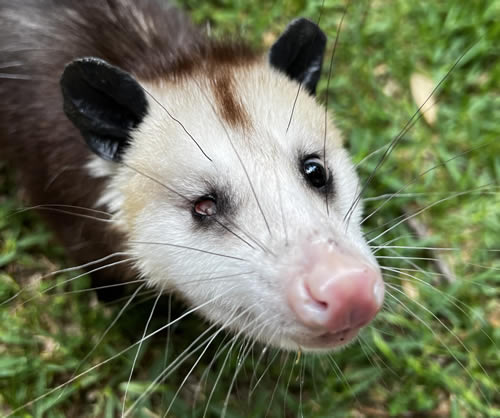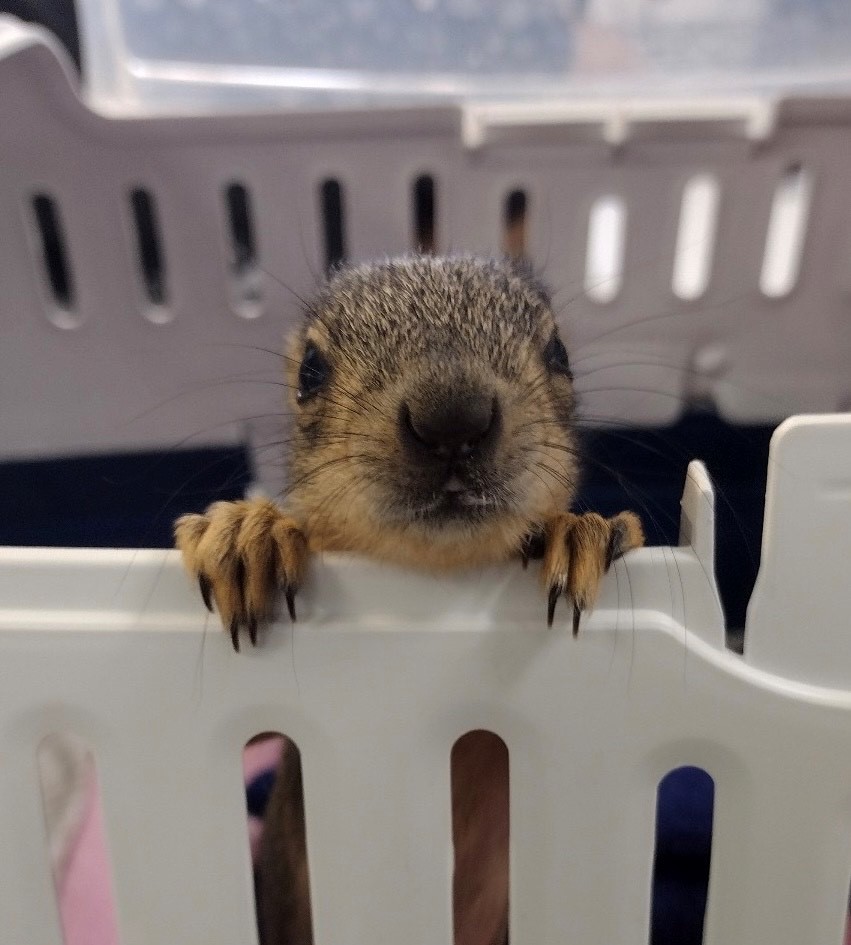Deterring Wildlife

General Information
The goal of deterrents is to make the area so uncomfortable that the wildlife moves away on its own. This is the most humane way to remove wildlife and ensure no babies are orphaned. Deterrents can be making a home less comfortable by removing attractants, making it uncomfortable by adding bad smells/sounds and other sensory annoyances, or some successful deterrents simulate a predator nearby to scare any wildlife away.
For the most effective results, the Houston Humane Society (HHS) Wildlife Center always suggests using multiple deterrents or sensory repellents in combination. To be humane, we suggest avoiding deterrents that could cause harm to other non-targeted wildlife. All humane deterrents should just make an animal scared or uncomfortable, we do not recommend poisoning or injuring any wildlife as a deterrent. These inhumane solutions are often only temporary because they only target one individual animal and do not fix the root/cause of the problem, so more wildlife will come in to fill the space.
To Trap or Not to Trap
The HHS Wildlife Center never recommends using baited live traps to relocate animals. The relocation of “nuisance wildlife” is only ever a temporary solution. It is best to use deterrent methods to evict an animal on its own terms to prevent any future animals from moving in. If an animal is trapped for removal, it will only leave a new niche in the habitat for a different individual to move in. Instead one should go after the root of the problem such as eliminating possible food sources attracting the animal. The relocation of wildlife is also detrimental to the animals' health. All animals are known to injure themselves when trying to escape from stressful cages and some experience capture myopathy. These injuries can be anything from a broken jaw to minor scratches that can get infected if left untreated.
Animals that are nesting in a home or near people also have a high chance of being mothers trying to raise their young. By trapping them, their babies left behind are orphaned, leading to a new unforeseen consequence of the trap. Forced relocation to a new area can leave the animal lost and confused, usually unable to find food and water sources. The introduction of a new animal leads to territorial disputes with wildlife already in the area. It is illegal to release an animal in any area without explicit written permission from the owner or governing entity of that land, which can often take weeks to acquire. We only suggest live traps as a last resort or if the animal is in such danger that its immediate removal is necessary. Even in these scenarios, traps have a high possibility of catching the wrong animal, because most are not exclusive to one species.
Mammals in the Home
The HHS Wildlife Center never recommends trapping and relocating healthy animals that the caller considers a “nuisance”. These animals often get injured during the process, do not survive well when placed in an unfamiliar area, and the caller may inadvertently orphan babies that they are unaware of.
The best way to resolve this situation is to use a scent deterrent to fool the animal into thinking that there is a predator in the area, prompting it to leave. Placing scent deterrents from the list below in areas where you commonly hear the animal can cause the animal to think there is a predator in the area, making them think it is unsafe. Once these products are placed in the area, the scent of the predator will cause the animal to move or collect any babies it has with it and leave. Once the animal leaves, any holes in the structure will need to be patched to ensure no future visitors. The following list is in a general order with the most effective solutions at the beginning followed by alternative but less effective sent options.
- Rags soaked in human, dog, or cat urine
- Fresh Cab Botanical Rodent Repellent
- Critter Ridder Animal Repellent Granules
- Small brown paper bags of used cat litter
- Animal hair
- Rags soaked in vinegar
- Human sweat on clothes (such as sweaty gym socks or a sweat-soaked shirt)
For best results, other deterrent methods should be combined with the predator scent deterrent, such as a motion-sensitive light or strobe light and a radio turned to a talk station (human voices will sound predatory to mammals, but music will not).
Once the animal has vacated the property, be sure to close up any possible entrances. Covering attic vents with mesh or installing chimney caps can help close off possible entrances, but check around the roof and baseboards of the home for any holes that need repairing as well. You can also add fences shaped like an “L” to prevent animals from digging around your home. For more information about installing these fences, see the “Mammals in/under Shed” section.
Mammals in the Garden
Yards and gardens create great urban sanctuaries for wildlife, naturally attracting them. If this is not something you want, the HHS Wildlife Center suggests making your yard less hospitable through a combination of visual, auditory, and smell deterrents.
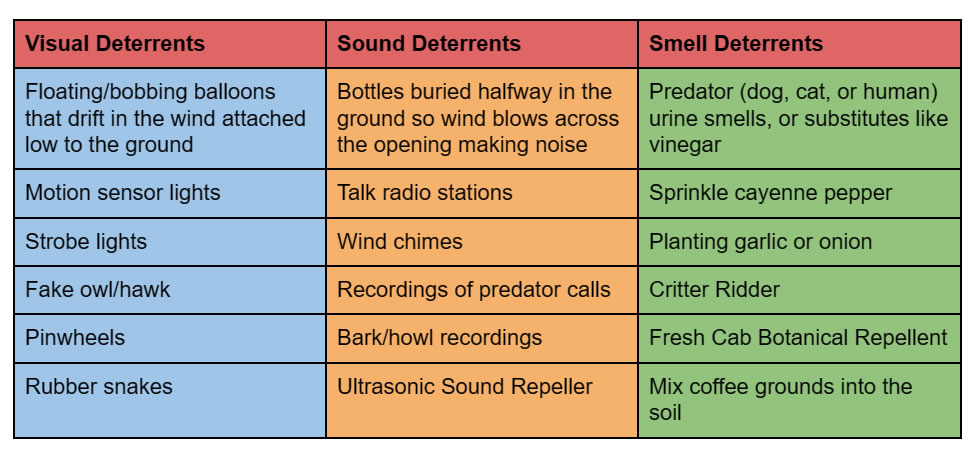
If you find wildlife digging holes in your garden, do not automatically assume rabbits, this is more likely from skunks or squirrels. Other ways to block out wildlife include burying mesh or chicken wire 1 inch below the surface of the soil so plants can still sprout between the holes but it protects the roots from being dug up.
Changing to raised planter boxes instead of in-ground planter beds will also decrease the amount of wildlife that will walk through the plants as well. If the beds are not able to be raised, placing small fences or covering the beds with mosquito mesh can protect them as well. Some products designed to protect against frost are also effective in keeping out wildlife.
Other ways to make your yard less welcoming to unwanted wildlife includes limiting the amount of resources animals have access to. Make sure nearby trash cans are covered, and there are no standing water sources. Adding a motion sensor sprinkler can also deter wildlife from the area.
Another reason an animal may be in your garden is to nest. Regularly clean up any debris like fallen leaves or grass clipping to remove possible nesting materials the animals might be using. Some animals might be using the ground cover to hide in, so removing other potential hiding spots will leave animals feeling unprotected and wanting to move out of the garden. This would include mowing the grass around the garden to be kept short at all times.
Mammals in/under Shed
If you find signs of an animal nesting under your shed, the best and easiest solution is to do nothing and wait for them to leave on their own. Most mammals, such as skunks, opossums, and raccoons, only inhabit their dens temporarily. This is because once their young are grown, they no longer need a den. Because raising young is the most likely cause for building a nest, trapping the mother or blocking off an entrance will leave the babies orphaned. To identify if a hole is being used as an entrance, place grass in the shape of an X in front of it and check for disturbances in the X formation. Once the season for having babies is over, the entrance can be sealed. For most entrances, the HHS Wildlife Center suggests sealing with mesh and filling any holes with dirt.
The most effective way to make a shed or porch wildlife-proof is to add L-shaped fencing around the border. This can be done with chicken wire or any sort of mesh but is most effective if using copper wire, or 16 gauge wire with 1-inch holes. The fence should have at least a 2.5-foot tall vertical portion reinforcing the lower portion of the shed wall. The horizontal portion of the fence running along the ground should extend out from the wall at least 1.5 feet to prevent the animal from tunneling below the wall. The horizontal portion of the fence does not have to be buried below the ground but can be buried a foot deep or secured to the surface with sod staples or other similar fastening materials.
Before installing a fence, make sure you are not trapping in any animals. If you see a possible entrance, place grass or sticks in the shape of an X near the entrance and check for disturbances overnight. It is never recommended to trap wildlife. Waiting for the animal to move on before installing any fencing is always the best solution. Sensory deterrents can also help encourage the resident to leave sooner.
For increased effectiveness, a mixture of other sensory deterrents listed in the “Mammals in the Home'' section or the “Mammals in the Garden” section can be utilized in combination. Be careful when using these deterrents for a home with pets as some dogs and cats will also be sensitive to these deterrents. Birds do not have a strong sense of smell or taste. Although mammals do not like the smell of vinegar, spice deterrents like cayenne pepper are the most effective at keeping out mammals without impacting the chickens.
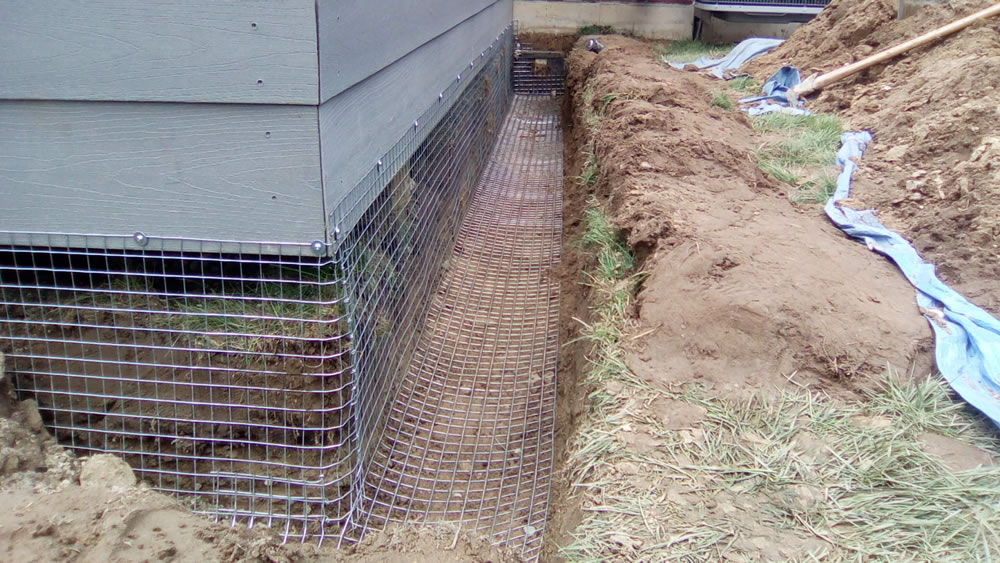
Chart of Breeding Seasons When Dens May Be in Use
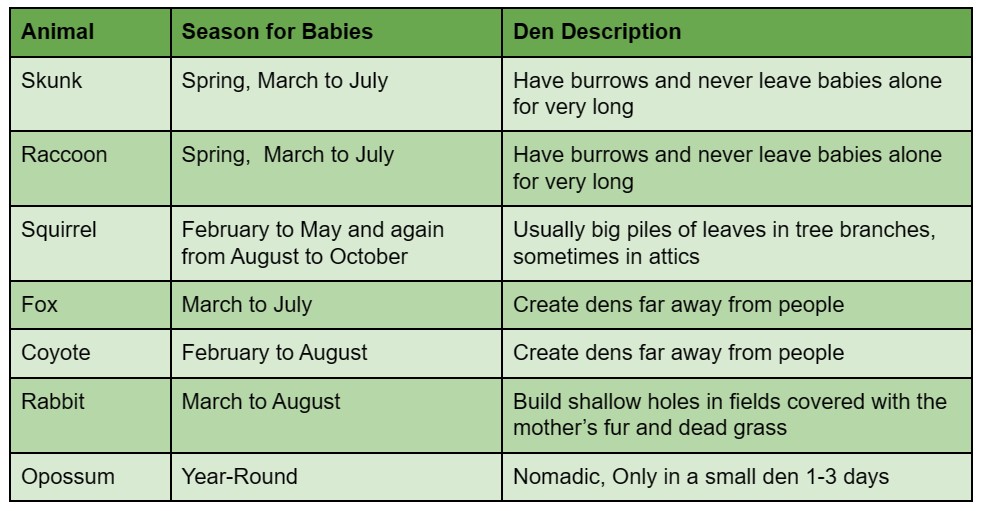
Opossums Wandering the Yard at Night
Opossums make great neighbors but we understand not wanting your pets to catch them when let out into the yard. If you frequently see opossums in your yard, then before letting any dogs or cats out at night, the HHS Wildlife Center suggests clapping loudly around your yard to scare off the opossums and giving them a few minutes to climb away. If you see a mother opossum with babies on her back or in her pouch we do not recommend this, as this can lead to her climbing away too fast and dropping her babies. Instead, just wait ten minutes for the mother opossum to move on from the yard. If clapping is unsuccessful, you can also try shouting, playing a loud radio, or flashing bright lights at the opossum to warn the opossum of danger and encourage them to move on from the yard.
If possible, we always recommend letting opossums stay in your yard for as long as needed. They are nomadic creatures that only remain in a den for 1-3 days while their babies are still in the pouch. These dens are usually made in a rush and are very weak, often only consisting of a few leaves wrapped around their tail. Besides this, they do not stay in one yard for long periods of time. Opossums tend to eat unwanted creatures like insects (including ticks), frogs, venomous snakes, and carcasses, making them great visitors to have. They do not have very strong claws so they rarely cause damage to properties when climbing over fences. Due to their lower body temperatures, they do not carry diseases such as rabies. They will frequently hiss or drool to make predators scared of them, but will more often pretend to be dead before lunging or trying to defend against a perceived threat. If they are cornered or feeling threatened then they may attempt to bite out of fear, but their bite is not as strong as some other mammals.
Wildlife Getting into Chicken Coop
Similar to keeping wildlife out of sheds, a mesh barrier tends to work best for chicken coops as well. An L-shaped barrier shown in the “Mammals in/under Shed” section works well for most animals, but if you are keeping snakes out, a finer mesh with smaller ¼-inch holes or smaller is recommended. All possible entry points should be sealed off with mesh barriers or silicone caulk around corners. Keep the area around the coop clean of any tall grasses or debris that wildlife prefer to hide in to maintain cover. Make sure all feed products are properly sealed to prevent unnecessary attractants to the coop.
For increased effectiveness, a mixture of other sensory deterrents listed in the “Mammals in the Home'' section or the “Mammals in the Garden” section can be utilized in combination. Be careful when using these deterrents for a home with pets as some dogs and cats will also be sensitive to these deterrents. To reduce the impact to the chickens, we suggest avoiding the visual and sound deterrents, instead prioritizing the smell deterrents. Birds do not have a strong sense of smell or taste. Although they still do not like the smell of vinegar, spice deterrents like cayenne pepper are the most effective at keeping out mammals without impacting the chickens.
Bird on the Porch/Roof
It can be wonderful seeing birds in the backyard or at bird feeders, but if they are on the porch they can often leave quite a mess. To keep pigeons or songbirds off the side of the house, the HHS Wildlife Center suggests first removing or moving any potential food sources. Bird feeders and seeds should be at least 10 feet away from any buildings, and all trash cans should be kept with secure lids covering them. For visual deterrents, we suggest using flashing motion sensor lights or fake predators like plastic owls or hawks. These are best paired with sound deterrents like talk radio stations played loudly, or recordings of larger predators. Birds do not have a strong sense of smell so smell deterrents are frequently not very effective against them.
If you see birds nesting on your property, it is illegal to tamper with native bird nests due to the Migratory Bird Treaty Act of 1918. Birds usually only nest for a month before moving on, once eggs and chicks are out of the nest it can be removed. To prevent birds from nesting in gutters, mesh can be installed covering the gutters.
Other physical boundary-type deterrents can be adding a thin wire over any perching points to make it uncomfortable to perch. Coyote Rollers can be installed on the top of fences to keep birds from perching as well. These rolling cylinders can be found at https://coyoteroller.com/.
Birds Hitting Windows
Although most birds have exceptional eyesight, it is still easy to get disoriented while flying, which can make it hard to see transparent barriers like windows. To help prevent birds from flying too close to windows, any feeders or birdhouses should be at least 10-20 feet away from any buildings to give them space to fly around them. The windows can be bird-proofed by adding visual barriers to make them easier to see and avoid. Some suggestions for these barriers are listed below.
- Installing blinds over windows
- Installing mesh screens over windows
- Adding decals or stickers to windows
- A “Do It Yourself” product would be adding Mod Podge or other tacky materials to cover windows to look more opaque
- Adding color or stained glass ornaments in windows
- Swapping out clear glass for frosted or decoratively cut glass
Woodpeckers Damaging Home
Woodpeckers usually only search for food in softer dead or dying wood sources. If woodpeckers are found drumming on your trees or home, there is a chance there are termites or other wood-burrowing insects in the area. Treating this problem is usually the best solution to encourage woodpeckers to move on. Often when woodpeckers are searching for food in trees it is beneficial to the tree for the woodpeckers to remove the insects, so it is best to let the woodpeckers work if they are not damaging the tree. If it does seem like the woodpeckers are causing damage to the tree, it is a sign the tree was dying before the woodpeckers got there. This should be looked at by a professional tree removal service for the safety of your home. Other deterrents to protect the side of your home or your trees are listed below.
- Temporarily wrapping trees in cling wrap or fabric
- Put up sheets or slick surfaces on the side of your home to prevent woodpeckers from landing properly
- Stringing ribbon in trees to deter landing when blowing in the wind
- Flashing lights and other visual effects that make the yard seem inhospitable
- Windchimes and talk radio stations playing in the area can become sound deterrents
What to do When Spotting Coyotes
Coyotes are very skittish and rarely a danger to people, but if seen, keep all pets indoors. It is not uncommon to see coyotes out during the day, and seeing one does not necessarily mean the coyote is unhealthy. The best way to deter coyotes from an area is not to shoot it. Shrinking the size of a pack will trigger a natural response in the coyotes to breed more, resulting in a larger pack to defend themselves. A dead coyote cannot return to its pack to teach them of the dangers of an area. Instead, use aversive conditioning or “hazing techniques” to frighten the coyote and warn them of the dangers of the neighborhood to teach them to stay away.
Hazing involves using deterrents to encourage animals to leave an area voluntarily. It can also help maintain coyotes' fear of humans and deter them from visiting community spaces such as backyards and playgrounds.
IMPORTANT: NEVER run from a coyote, it is always better to stand your ground!
How do I haze a Coyote?:
- Blowing a whistle or air horn at the coyote.
- Yelling while waving your arms to appear large and aggressive.
- Make a homemade noisemaker with a can and some small objects to shake around. You can use pennies, and a soda can, sealed up with duct tape.
- Use a hose or squirt gun to spray the coyote.
- Throwing rocks or sticks toward the coyote (not directly at them).
Hazing has the greatest impact on a lone coyote when carried out by multiple individuals using various tools and techniques every time the coyote is spotted.
Hazing can also be directed towards a pack of coyotes. Typically, there is a dominant breeding pair that will guide the group away from the area if they sense any danger.
A guaranteed way to keep coyotes off the property is to add chain link fences or attach a coyote roller to the top of a fence. These devices are sold at https://coyoteroller.com/ and prevent all wildlife from climbing or perching on fences. They can also be homemade using PVC pipe.
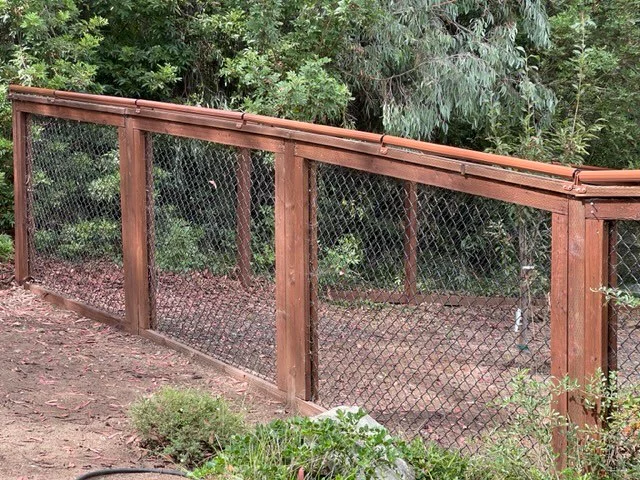
Unwanted Animals at the Bird Feeder
Squirrels are notorious for raiding bird feeders, but other mammals have been known to make unwelcome stops. To make your bird feeders limited to flying friends only, the most common trick is to attach a baffle. A baffle is a wide cone attached below the seed portion of the bird feeder on the pole or stand. The most effective baffles have a 15-inch diameter and are at least four feet off the ground. Other deterrents for climbers are to attach wire like a slinky to the pole below the bird seed, making it too hard to climb up. Baffles can also be attached above a hanging bird feeder although these are often less effective because squirrels will jump down from trees onto a feeder. For hanging bird feeders, the HHS Wildlife Center suggests attaching them to a spring so a heavy animal like a squirrel will tip the feeder or cause it to bounce resulting in a squirrel being unable to hold on long enough to get seed. Feeding squirrels at alternative locations will often distract them for long enough that the birds can focus on the seed before the squirrels get to it. Replacing a traditional bird seed dispenser with a suet cake holder can also deter squirrels from visiting while still remaining a resource for songbirds.
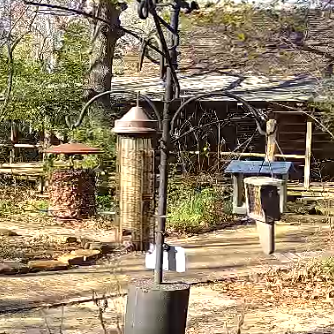
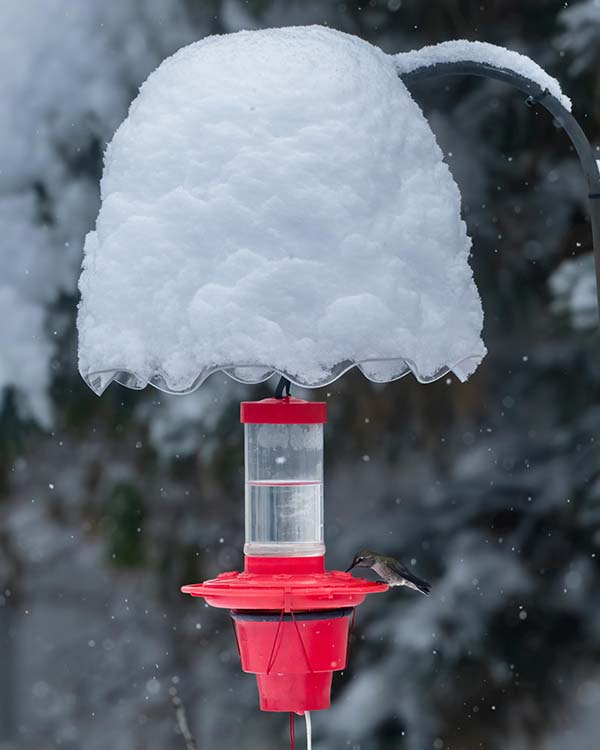
Images of above and below protection system on bird feeder
If the unwanted guest at the bird feeder is a predator like a hawk or owl, we suggest temporarily taking down a bird feeder to disperse any songbirds and remove the source of prey for a predator until the predator moves on. Keeping a bird feeder under a tree will help give any songbirds cover and protection from being spotted by a predator too.
Insects in the Home
Poisons and other killers are usually only temporary solutions as they only kill individual insects one at a time. Examples of in-home deterrents include containing food sources that could be acting as attractants and spraying/applying vinegar rags to suspected insect entrances. Out-of-home deterrents include removing standing water sources and planting plants that have offensive smells.
In addition to vinegar, other smells that are known to deter ants and mosquitos are:
- Catnip
- Lemongrass
- Lemon balm
- Basil
- Peppermint
- Rosemary
- Citronella (do not plant near pets)
Glue or sticky traps often leave the bugs exposed, causing the paper to attract other insectivores. This results in trapped birds or other small wildlife that become the unintended victims of this torturous way to die. Bug zappers and sweet-smelling traps also sometimes inadvertently harm the wrong target animal and attract birds and insects.
Diatomaceous earth can be sprinkled into gardens as well as around the home to deter ants and other insects. Although diatomaceous earth has no known impacts on other wildlife, any harsh chemicals should always be used sparingly. Spraying harmful insecticides heavily can lead to unintended consequences as most of these chemicals get washed away in runoff and unintentionally poison predators, becoming a major source of pollution in Texas waterways.
Ducklings in the Pool
-
First open the gate so that when the mom and babies are reunited, they can leave on their own. Don’t make noises or sudden movements that might scare the mother away.
Note: If the parent is not seen, look around for them thoroughly in nearby trees and on the ground since they may be present but well hidden.
-
Fashion a ramp from lighter, floating objects such as a kitchen mat, the lid of a styrofoam cooler, or the floating cushion of a deck chair. Tie the object to the pool ladder or a nearby tree to create a diagonal ramp leading out of the pool. If a heavier material such as wood plank is used, attach an empty 2-liter bottle or foam pool noodle to the underside to make it float.
Note: If the babies hesitate to leave the pool, placing floating objects in the pool such as beach balls or other toys will make the water less appealing. Windup or remote control toys are more effective. Do not try to feed the ducks to lure them out as this will only encourage them to stay.
-
If the parent is present, monitor from a distance to ensure that she reunites with them. If there is no parent, put the babies in a box lined with t-shirt material or a towel and make arrangements to bring them to a wildlife center or rehabber. Give us a call at 713-468-8972 or try using Animal Help Now (ahnow.org) to find a center or rehabber near you.
Note: Duckling babies have strong little legs and will jump out of hands suddenly. This could result in injury or escape, so be mindful of this and transfer them quickly and carefully while staying low to the ground.
Glue Traps and Humane Alternatives
Glue traps are extremely inhumane because they prolong the suffering of the animals caught in them. Glue traps capture a wide variety of wildlife and rarely successfully capture the targeted species. For any species, being trapped in a toxic chemical like glue for hours, or days, can be deadly. Whether it be from being poisoned by the glue, or starving to death, it is an awful way to pass. Instead, consider some deterrents previously mentioned based on your situation, call a humane trapper, or use a humane live trap for release.
Recommended Humane Trappers and Home Repair Services:
- Paul Miller - (713) 417-7920
- 911 Wildlife - (713) 287-1911
- All Creatures Pest Control - (832) 343-7848
Live Trap and Release Recommendations:
If deterrent methods aren't working or are unsuitable for your situation, use a “live trap and release” containment method instead of a glue trap. Look for products that specifically mention “humane” or “live.” Products that trap using snapping mechanisms, such as a traditional mouse trap, are very harmful to any animal that sets it off. By using a product that resembles a cage, the animal can safely wait until it is found and moved to be released nearby outside the home. Also, consider a reusable trap. Because trapping methods rarely effectively target one desired species, be prepared to reset the trap multiple times after catching the incorrect animal.
 Image from Tomahawk Live Trap of a humane trap alternative
Image from Tomahawk Live Trap of a humane trap alternative
If you do find an animal stuck in a glue trap, do not attempt to remove it. This can often cause more harm than good. Birds may lose feathers and mammals may have fur ripped out, this is extremely stressful for the animal and may prove fatal in some circumstances. Instead, call our hotline at 713-468-8972 immediately so it can go to the closest wildlife center as soon as possible for immediate care.
Other Specific Animal Scenarios
To prevent deer from entering your yard, the fence must be at least 8 feet tall.
If you find an unwanted snake in the yard, the safest option for you and the snake is waiting for the snake to move away on its own. If you must take action, simply spraying the snake with water from a hose will convince it to move on.
- Another deterrent is to stand 10 feet away and stomp the ground to alert the snake of your presence.
- To deter snakes from your yard, we suggest removing potential hiding spots and keeping dead leaves or debris off the ground.
If you have frogs/toads making noise at night, remove any potential standing water sources. Amphibians like to live in damp places, such as under porches and patios. Create exit-only escape routes before blocking off these areas.
- The easiest exit-only escape route is a cone-shaped hole with the large end facing in towards where the frogs are moving away from.
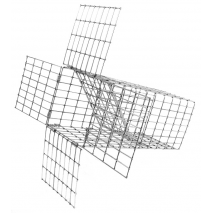
One-way excluder attachment from Tomahawk Live Traps
If you regularly find your garbage turned over, it means it is likely attracting wildlife to eat from it. To prevent this we suggest screwing the lid closed with a bungee cord or buying a garbage can with a screw-on lid. Trash should also be kept in a garage or shed overnight to keep it from animals. If you find an animal like a raccoon or opossum in your garbage can, tip the whole garbage can on its side and wait for the animal to escape on its own.
If the animal is found in a dumpster, place a ramp inside to give the animal access to escape while the lid is open. This ramp should ideally be placed at a 45-degree angle and should be strong enough to hold the weight of the animal, such as a 2x4 plank of wood.
If you find bats in your area, be careful not to touch them. Bats can be great neighbors to have due to the large amount of insects (like mosquitoes) they eat each night. If they are in your home it is best to hire a professional to remove them. HHS Wildlife Center’s recommended humane trapper is Paul Miller at 713-417-7920.
It is illegal to tamper with most eggs or nests of native wildlife, including turtle nests. If you do find any wild aquatic turtles, it's often because they are searching for a place to lay their eggs and should not be disturbed. If it is a land turtle, then it is most likely an escaped or abandoned pet that should be brought to a center or rehabilitator such as Gina Disteldorf at 502-413-1055. To keep turtles from going into your yard, we suggest reinforcing the bottom of all fences so there is no gap below.
If you hear noise coming from your chimney, it could be a chimney swift! These birds nest exclusively in chimneys and cause little to no structural damage. Some mammals are also known to find their way into chimneys. Recordings of the sounds different animals make can be found on YouTube for comparison. All animals should be humanly removed from a chimney before installing a chimney cap or closing up any entrances.

